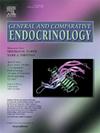Global analysis of ligand-gated ion channel conservation across Platyhelminthes
IF 1.7
3区 医学
Q3 ENDOCRINOLOGY & METABOLISM
引用次数: 0
Abstract
Ligand-gated ion channels (LGICs) are critical for neurotransmission, mediating responses to neurotransmitters and hormones, and influencing diverse physiological processes. This study identifies and classifies LGICs across Platyhelminthes, with a particular focus on parasitic neodermatans, which impact human and animal health. Using bioinformatics tools, we analyzed LGICs from 41 neodermatan species and expanded our investigation to encompass vertebrates, other invertebrates, and non-bilaterians to trace LGIC evolutionary pathways across Metazoa. We identified 2,269 putative LGICs within neodermatan species, which we classified into the cys-loop, ASIC/Deg/ENaC, iGluR, and P2X families. Our phylogenetic and clustering analyses reveal lineage-specific patterns with distinct evolutionary trajectories for each LGIC family in neodermatans compared to free-living platyhelminths and other taxa. Notably, the ASIC/Deg/ENaC family displayed the greatest degree of neodermatan-specific divergence, while cys-loop and P2X families were more conserved across taxa. To provide insight into their potential physiological roles, we analyzed LGIC expression patterns in Schistosoma mansoni, revealing widespread expression across neuronal and muscle cell types. The distribution of acid-sensing ion channels (ASICs) in both neurons and muscles suggests a role in neuromuscular signalling, while the P2X receptor (Smp_333600) exhibited sex-specific expression, potentially indicating distinct functional roles in males and females. Additionally, several cys-loop acetylcholine and GABA receptors showed differential neuronal and muscle expression, highlighting their likely contributions to cholinergic and inhibitory neurotransmission. These findings underscore the relevance of LGICs in parasite physiology, particularly in neuromuscular and sensory processes, and suggest potential targets for antiparasitic interventions.
配体门控离子通道保护的全局分析。
配体门控离子通道(lgic)在神经传递中起着至关重要的作用,介导对神经递质和激素的反应,并影响多种生理过程。本研究确定并分类了platyhelmintes的LGICs,特别关注影响人类和动物健康的寄生虫neodermatans。利用生物信息学工具,我们分析了41种新生皮肤动物的LGICs,并将研究范围扩大到脊椎动物、其他无脊椎动物和非双边动物,以追踪后生动物的LGICs进化途径。我们在新生皮肤病物种中鉴定了2269个推定的lgic,并将其分为cys-loop、ASIC/Deg/ENaC、iGluR和P2X家族。我们的系统发育和聚类分析揭示了与自由生活的扁形蠕虫和其他分类群相比,新生皮肤动物中每个LGIC家族具有独特的进化轨迹的谱系特异性模式。值得注意的是,ASIC/Deg/ENaC家族在不同分类群中表现出最大程度的皮肤病特异性分化,而cys-loop和P2X家族在不同分类群中更为保守。为了深入了解其潜在的生理作用,我们分析了LGIC在曼氏血吸虫中的表达模式,揭示了其在神经元和肌肉细胞类型中的广泛表达。酸感离子通道(asic)在神经元和肌肉中的分布表明其在神经肌肉信号传导中起作用,而P2X受体(Smp_333600)表现出性别特异性表达,可能表明在男性和女性中具有不同的功能作用。此外,几种半胱氨酸环乙酰胆碱和GABA受体在神经元和肌肉中表现出不同的表达,突出了它们可能对胆碱能和抑制性神经传递的贡献。这些发现强调了LGICs在寄生虫生理学中的相关性,特别是在神经肌肉和感觉过程中,并提出了抗寄生虫干预的潜在目标。
本文章由计算机程序翻译,如有差异,请以英文原文为准。
求助全文
约1分钟内获得全文
求助全文
来源期刊

General and comparative endocrinology
医学-内分泌学与代谢
CiteScore
5.60
自引率
7.40%
发文量
120
审稿时长
2 months
期刊介绍:
General and Comparative Endocrinology publishes articles concerned with the many complexities of vertebrate and invertebrate endocrine systems at the sub-molecular, molecular, cellular and organismal levels of analysis.
 求助内容:
求助内容: 应助结果提醒方式:
应助结果提醒方式:


